Journal of the Ceramic Society of Japan
vol. 133, no.11, 2025
◆Full paper◆
Surface step motion on the (001) surface of strontium titanate single crystals during DC electric field-assisted flash treatment
 https://doi.org/10.2109/jcersj2.25102
https://doi.org/10.2109/jcersj2.25102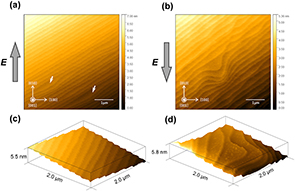
Shusuke Komori, Yutaro Katsuyama, Tomoharu Tokunaga and Takahisa Yamamoto
635
A DC electric field-assisted flash treatment was performed on the (001) surface of a SrTiO3 single crystal on which a step-terrace structure had been formed in advance (by solution etching). The DC electric field was applied along the direction that the surface height increases (up-step) or decreases (down-step) for a very short treatment duration of 1 min. The step-terrace morphology on the (001) surface was observed by atomic force microscopy, and the results were primarily discussed in terms of step stabilization or destabilization. Applying the DC electric field in the up-step direction appeared to stabilize the steps overall, although slight wandering was observed. Conversely, the steps were destabilized when the DC electric field was applied in the down-step direction, and the steps wandered significantly, with terraces protruding in the direction that the surface height decreases. The dependence of the step-terrace morphology on the direction of the DC electric field was consistent with previous studies that employed static electric fields (without a flash event). However, the step-terrace morphology may eventually become destabilized when the DC flash treatment time is extended, regardless of the applied field direction, considering the treatment duration of 10 min used in a previous study. This is inferred to be attributed to the amount of material diffusion relative to that of surface diffusion, which is increased by athermal effects during flash treatment.
◆Special Article-Advancements◆
The 79th CerSJ Awards for Advancements in Ceramic Science and Technology: Review
Changes in the crystal structure of layered perovskite compounds A3B2O9 (A = Ba, Sr; B = W, Re)
 https://doi.org/10.2109/jcersj2.25073
https://doi.org/10.2109/jcersj2.25073
Daisuke Urushihara
642
Layered perovskite compounds exhibit various electrical properties due to their crystal structure. This review focused on the synthesis and characterization of B-cation-deficient hexagonal perovskite A3B2O9 (A = Ba, Sr; B = W, Re), which exhibits two-dimensional perovskite layers and perovskite layer stacking along the [111] direction in the simple perovskite notation. Ba3W2O9, Sr3W2O9, and Sr3Re2O9 were obtained through high-pressure synthesis. Crystal structure analysis was conducted using single crystal X-ray diffraction and transmission electron microscopy. Ba3W2O9 was found to be isostructural with Ba3Re2O9 and exhibited no octahedral rotation and tilt. By contrast, Sr3W2O9 and Sr3Re2O9 were hettotype structures of Ba3W2O9 at 298 K and demonstrated phase transitions related to octahedral rotation and distortion. The substitution of Sr for Ba at the A-site induced compressive chemical pressure and crystal structure changes. The crystallographic differences between Sr3W2O9 and Sr3Re2O9 were octahedral tilts related to the 5d electron configuration. In A3B2O9 (A = Ba, Sr; B = W, Re), the substitution in the A- and B-site cations changed the octahedral rotation and distortion.
◆Full papers◆
Power generation characteristics of a single oxide fuel cell using a c-axis oriented apatite-type (La0.8Nd0.2)9.33Sr0.37Si5.7Mg0.3O26.065 ceramic electrolyte fabricated using a neodymium magnet
 https://doi.org/10.2109/jcersj2.25107
https://doi.org/10.2109/jcersj2.25107
Susumu Nakayama
650
In solid oxide fuel cells (SOFCs), oxide ion conductors are suitable electrolytes to separate the fuel electrode from the air electrode, and their conductivity has room for improvement. We obtained high oxide ionic conductivity in La9.7Si5.7Mg0.3O26.25, an oxygen-rich apatite-type lanthanum silicate ceramic involving the partial substitution of Si with Mg in La9.7Si6O26.55. Moreover, partial substitution of La with Sr yielded La9.33Sr0.37Si5.7Mg0.3O26.065, which exhibited the highest bulk ionic conductivity (1.9 × 10−2 S·cm−1 at 500 °C), representing a 1.6-fold increase compared to La9.7Si6O26.55 at 500 °C. To orient La9.33Sr0.37Si5.7Mg0.3O26.065 in a magnetic field using a neodymium magnet with c-axis orientation, La was partially replaced by Nd, a trivalent rare earth element with magnetic properties, to prepare (La0.8Nd0.2)9.33Sr0.37Si5.7Mg0.3O26.065, yielding c-axis oriented products. The ionic conductivity of the bulk parallel to the c-axis (σ//, 5.5 × 10−2 S·cm−1 at 500 °C) was 1.9 orders of magnitude higher than that of the bulk perpendicular to the c-axis (σ⊥) at 500 °C. An SOFC incorporating (La0.8Nd0.2)9.33Sr0.37Si5.7Mg0.3O26.065 as the electrolyte [3 % H2 (Ar balance) | Pt | Sm0.2Ce0.8O1.9 | electrolyte | Sm0.2Ce0.8O1.9 | Pt | air] was fabricated using a 1-mm thick c-axis oriented product. The maximum power outputs at 450, 500, and 550 °C were 29, 60, and 70 mW·cm−2, respectively.
Enhancement of lanthanum ion conductivity by (40−2) plane orientation of polycrystalline La4Ga2O9
 https://doi.org/10.2109/jcersj2.25106
https://doi.org/10.2109/jcersj2.25106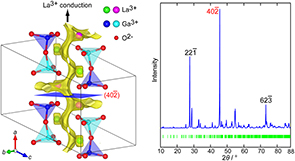
Kakeru Shimotsukasa, Daisuke Urushihara, Toru Asaka, Tohru S. Suzuki and Koichiro Fukuda
657
To enhance the conductivity of La3+, the (40−2) plane aligned polycrystalline La4Ga2O9 (space group P21/c) was prepared by sintering at 1673 K for 2 h after colloidal processing under a high magnetic field of 12 T. The textured polycrystal was characterized by X-ray diffraction and impedance spectroscopy with respect to the grain alignment direction. The (40−2) plane normal of each constituent crystal grain of the polycrystal was found to be almost parallel to the applied magnetic field. The texture fraction of (40−2), expressed as the Lotgering factor f40−2, was 0.235. A comparison was made of the conductivities parallel (σ∥) and perpendicular (σ⊥) to the aligned plane normal at temperatures ranging from 673 to 1073 K. These were also compared with the conductivity (σr) of randomly grain-oriented La4Ga2O9 polycrystal. The σ∥, ranging from 1.63 × 10−7 S cm−1 at 623 K to 8.52 × 10−4 S cm−1 at 1073 K, demonstrated the highest value at each temperature, followed by σr and σ⊥ in that order. The σ∥/σ⊥ ratios ranged from 10.0 at 673 K to 15.2 at 1073 K, and the σ∥/σr ratios ranged from 6.7 at 873 K to 8.3 at 1073 K. Since the a-axis is almost parallel to the (40−2) plane normal, the enhanced La3+ conductivity of the La4Ga2O9 polycrystal has confirmed, for the first time, the prediction by the bond valence energy landscape method in the literature that La3+ conduction is preferential along the a-axis.
Ferroelectric–paraelectric phase transition in Ba(ZrxTi1−x)O3 epitaxial films on MgO substrates for enhanced tunable dielectric properties
 https://doi.org/10.2109/jcersj2.25071
https://doi.org/10.2109/jcersj2.25071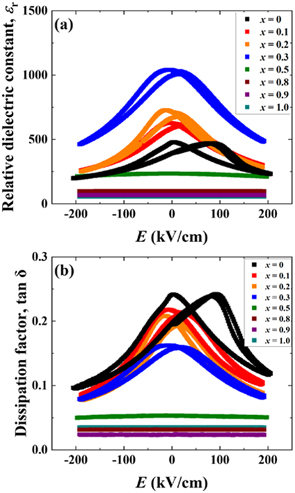
Ryo Takahashi, Yosuke Hamasaki, Shinya Sawai, Yasuyuki Hirata, Yoshihiro Miyauchi, Shintaro Yasui, Hiroshi Funakubo, Yoshitaka Ehara and Ken Nishida
663
BaTiO3-based ferroelectric materials have been extensively studied for tunable microwave device applications. Ideal tunable materials exhibit high dielectric tunability and a low dissipation factor. In this study, we investigated the crystal structure and dielectric properties of 500-nm-thick Ba(ZrxTi1−x)O3 (BZT) epitaxial films deposited on (100)cSrRuO3//(100)BaZrO3//(100)MgO substrates via pulsed laser deposition. The X-ray diffraction (XRD) patterns of the films showed only (00l)/(100) peaks, indicating the absence of secondary phases. XRD and second harmonic generation measurements revealed a ferroelectric-to-paraelectric phase transition in the x range of 0.21–0.30. Further characterization of the ferroelectric and dielectric properties of the films revealed that the BZT films exhibited high tunability near the phase transition composition, and the increase in the dissipation factor was suppressed.
Study on the coloration mechanism of Jingdezhen ox-hair pattern copper-red glaze
 https://doi.org/10.2109/jcersj2.25097
https://doi.org/10.2109/jcersj2.25097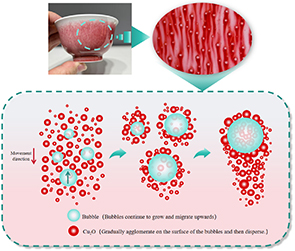
Min Yang, Li Liu, Yan Liang, Lifeng Miao, Junming Wu, Ling Qiu and Naizhang Zheng
670
As a classic representative of Jingdezhen’s high-temperature colored glazes, the ox-hair pattern derived from copper-red glaze surfaces embodies a distinctive visual symbol of Eastern aesthetics. This study systematically deciphers the coloration mechanism of ox-hair-patterned copper-red glazes using modern materials science methodologies (EDXRF, OM, TEM, SEM, XPS, UV–Vis). The research confirms that microscopic examination of the glaze layer reveals crystal-enriched zones with significantly higher crystal density compared to surrounding areas. These zones exhibit vivid red hues attributed to nanoscale Cu2O particles (10–30 nm in diameter). Crucially, these particles do not disperse randomly but undergo ordered aggregation and enrichment along entrapped bubble interfaces. This directional enrichment not only intensifies the visual impact of the red zones but also elucidates the unique behavior and interaction mechanisms of nanoparticles within the glaze layer. The study identifies the primary chromogenic substances in ox-hair-patterned copper-red glazes, providing a technical and theoretical foundation for further research into process control.
Zeolite synthesis from coal ash using ultrafine-bubble-containing solution
 https://doi.org/10.2109/jcersj2.25087
https://doi.org/10.2109/jcersj2.25087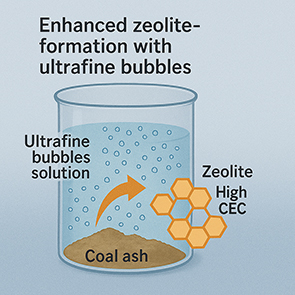
Takayuki Nuruyu, Ayaka Tutumiuchi, Kenji Shida, Shinfuku Nomura and Motohide Matsuda
679
Zeolite synthesis from coal ash was investigated using a solution containing ultrafine bubbles in a system with a production capacity of 60 kg/batch as a prototype for actual production. The formation of zeolite P was enhanced by the presence of ultrafine bubbles in the reaction solutions. Cation exchange capacities of about 2.3 mol/kg were obtained with a treatment time 4 h at 98 °C. The accelerated formation of zeolite P from coal ash in the ultrafine-bubble-containing solutions was responsible for the high cation exchange capacities.
Improving the efficiency and stability of perovskite solar cells through a multi-cycle methylammonium iodide spin coating approach assisted by the Ostwald ripening method
 https://doi.org/10.2109/jcersj2.25096
https://doi.org/10.2109/jcersj2.25096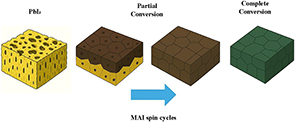
Tharaka Wanigasekara, Dilan Wijekoon, Shoji Kaneko, Masaru Shimomura, Hiroya Ikeda and Masayuki Okuya
684
In this study, we report a modified two-step deposition process for fabricating perovskite solar cells (PSCs), employing a multi-cycle spin-coating treatment of methylammonium iodide (MAI). This approach promotes the formation of the perovskite (PKT) phase through improved infiltration of MAI and grain growth driven by the Ostwald ripening process (ORP). As a result, enhanced crystallinity, improved surface morphology, and complete conversion of PbI2 into the PKT phase were achieved. Furthermore, ORP-driven grain growth reduced grain boundary density and enhanced photovoltaic (PV) performance, achieving a power conversion efficiency as high as 8.85 %. In addition, the devices fabricated using the modified spin-coating method showed improved PV performance retention under ambient conditions with continuous illumination, demonstrating superior long-term operational stability. These results highlight the strong potential of the multi-cycle MAI spin-coating treatment to address key challenges in PSCs, contributing to the advancement of their commercialization.
Study on cross-material property prediction of mineralizer fiber ceramic core materials based on deep learning
 https://doi.org/10.2109/jcersj2.25089
https://doi.org/10.2109/jcersj2.25089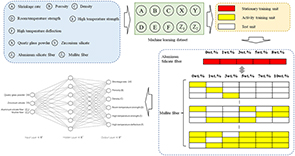
Qing Zhu, Yikui Xie, Weidong Xuan, Songzhe Xu and Zhongming Ren
693
In this study, silicon-based ceramic cores were prepared using aluminum silicate fiber and mullite fiber as mineralizing agents through injection molding. A comprehensive properties evaluation model was proposed, optimizing the weight coefficient. The back-propagation (BP) neural networks were employed to predict the effects of different mineralizers on ceramic core properties, establishing a cross-material property mapping and prediction model. The results showed an abnormal increase in mean square error with the addition of 1 wt.% aluminum silicate fiber, indicating complex material behavior. Blending model predictions demonstrated the neural network’s strong capability in cross-material property prediction. The predictions closely matched experimental results, confirming the model’s accuracy.
◆Technical report◆
Effect of cristobalite on the response to indentation in potassium-fluorrichterite glass-ceramics
 https://doi.org/10.2109/jcersj2.25077
https://doi.org/10.2109/jcersj2.25077
Keitaro Hiraoka, Gaku Okuma, Akihisa Takeuchi, Masayuki Uesugi, Yuki Sada, Ken-ichi Katsumata, Atsuo Yasumori and Kei Maeda
703
Glass-ceramics containing potassium-fluorrichterite (KNaCaMg5Si8O22F2) as the primary crystalline phase are known for their high bending strength and fracture toughness. It is also recognized that cristobalite precipitates in the commercial product as a secondary phase. This study investigated the response to indentation to identify the effect of cristobalite in potassium-fluorrichterite glass-ceramics with a chemical composition similar to that of the commercial product. The results revealed that the addition of 0.79 wt % Li2O promoted the precipitation of cristobalite during heat treatment at temperatures up to 1000 °C. A distinct volume change associated with the α–β phase transition of cristobalite was observed at approximately 200 °C. Vickers indentation tests indicated that hardness decreased with the growth of potassium-fluorrichterite crystals and further declined with the precipitation of cristobalite. The glass-ceramics containing both potassium-fluorrichterite and cristobalite exhibited permanent, hemispherical surface deformation in ball indentation tests. Synchrotron radiation X-ray computed tomography revealed the formation of microcracks in the cristobalite-containing glass-ceramics. It was suggested that the microcracks generated by stresses arising from the cristobalite phase transition led to the deformation and consequently contributed to the ductile behavior of the material. The findings of this study are expected to provide valuable insights into the microstructural design of cristobalite-containing glass-ceramics with enhanced mechanical performance.
◆Note◆
Growth of flower-like ZnO microcrystals with good symmetry by mist chemical vapor deposition
 https://doi.org/10.2109/jcersj2.25103
https://doi.org/10.2109/jcersj2.25103
Ayumu Ohashi and Tetsuya Kouno
709
Using the mist chemical vapor deposition (mist-CVD), a potentially low-environment-impact and low-cost crystal growth technique, ZnO microcrystals with unique geometries were grown. Their geometries comprised two parts: a stem-like microwire and flower-petal-like microcrystals with a six-fold symmetry. The flower-like ZnO microcrystals were covered with numerous nanocrystals that were almost regularly arranged on their surface. Furthermore, by selectively enhancing the crystal growth of mist-CVD, regularly arranged flower-like ZnO microcrystals were achieved on a substrate.
◆Announcement◆
Call for a Guest Editor for the Feature
 https://doi.org/10.2109/jcersj2.133.A11-1
https://doi.org/10.2109/jcersj2.133.A11-1A11-1
© Copyright by The Ceramic Society of Japan

